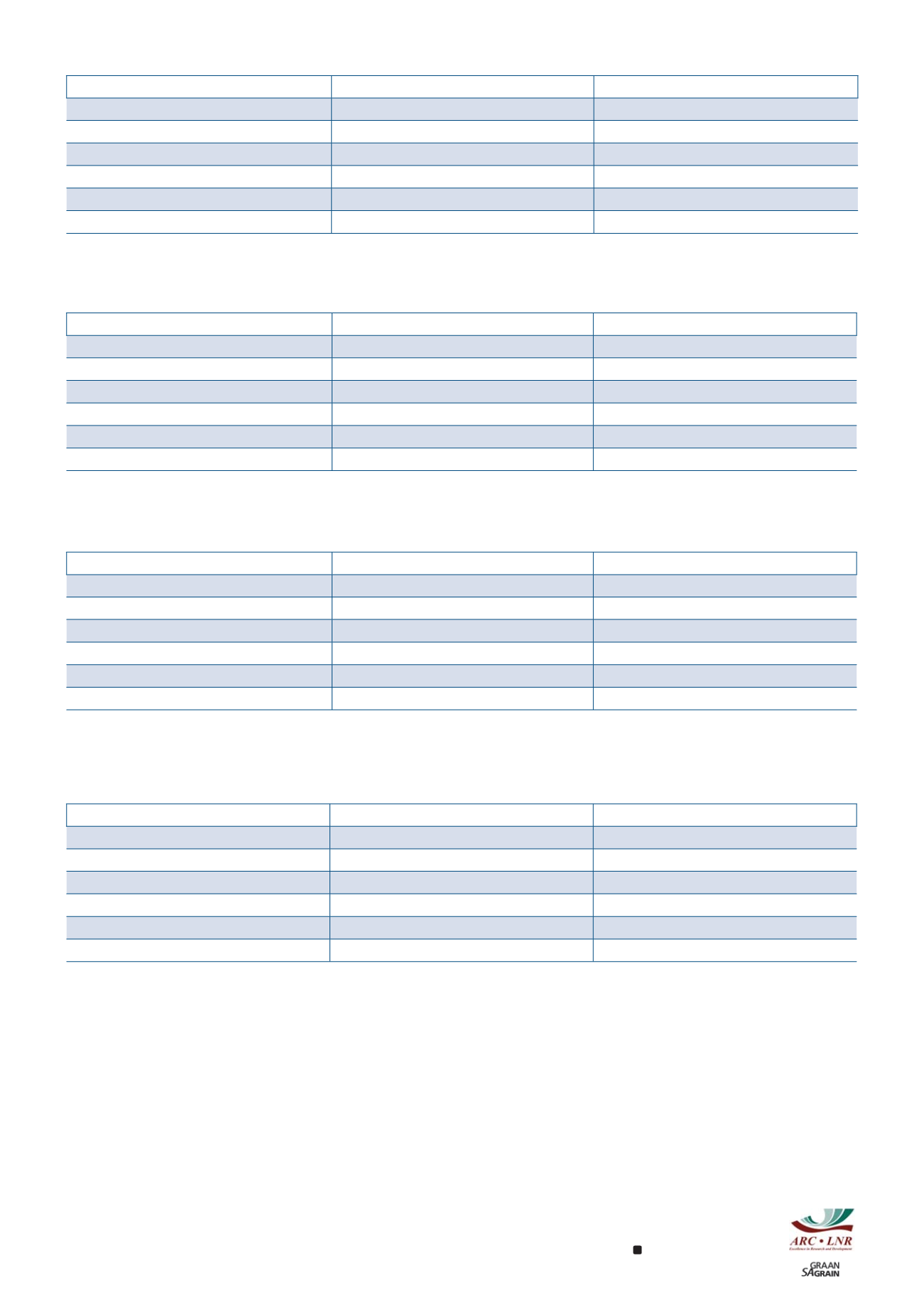

93
March 2018
* CT – Conventional till
# NT – No-till
CROP SYSTEM
CULTIVATION
FUSARIUM GRAMINEARUM DNA (NG/μL)
Maize monoculture
CT*
4,63
a
Maize monoculture
NT#
20,03
a
Maize
cowpea
NT#
2,62
a
Maize
sunflower
NT#
14,86
a
Maize
babala
cowpea
NT#
59,07
b
Maize
babala
sunflower
NT#
11,66
a
TABLE 2: MEAN FUSARIUM GRAMINEARUM TARGET DNA QUANTIFIED DURING THE 2010/2011 SEASON IN MAIZE GRAIN GROWN
UNDER DIFFERENT TILLAGE/ROTATION SYSTEMS IN BUFFELSVALLEI.
a fumonisin level (8,87 mg/kg) above the allowable legal limit for
human consumption (4 mg/kg) in the 2011/2012 season.
Trace amounts of deoxynivalenol levels pose no health threats when
this maize is consumed by humans or animals.
Erfdeel
Cropping systems had no significant effects on fungal infection or
mycotoxin accumulation in maize grain obtained from trials con-
ducted at Erfdeel.
Conclusions of this study
It appears that the season had a greater effect on Gibberella ear rot
infection, Diplodia ear rot incidence, fumonisin and deoxynivalenol
accumulation compared to cropping systems. Although statistical
analyses showed that the cropping system had a significant im-
pact on Diplodia ear rot, fumonisins and deoxynivalenol, the units
of measurements (except for the fumonisin level of 8,87 mg/kg in
the maize
sunflower rotation) were low and therefore these fungi
and mycotoxins were not a threat to the production of high yielding
safe maize.
The results of this study indicate that conservation agriculture sys-
tems under the environments evaluated, did not increase the risk of
maize ear rots and mycotoxin production.
For more information contact Dr Belinda Janse van
Rensburg at
BelindaJ@arc.agric.zaor Prof Bradley
Flett at
FlettB@arc.agric.za .* CT – Conventional till
# NT – No-till
TABLE 3: MEAN DIPLODIA EAR ROT INCIDENCE IN MAIZE GRAIN SAMPLES QUANTIFIED DURING THE 2010/2011 SEASON IN MAIZE
GRAIN GROWN UNDER DIFFERENT TILLAGE/ROTATION SYSTEMS IN BUFFELSVALLEI.
CROP SYSTEM
CULTIVATION
DIPLODIA EAR ROT INCIDENCE (%)
Maize monoculture
CT*
0,4706
b
Maize monoculture
NT#
0,3368
b
Maize
cowpea
NT#
0,5093
b
Maize
sunflower
NT#
0,2971
b
Maize
babala
cowpea
NT#
2,1065
a
Maize
babala
sunflower
NT#
1,3904
a
* CT – Conventional till
# NT – No-till
Values in brackets indicate log base 10 transformed data
TABLE 5: MEAN DEOXYNIVALENOL CONTAMINATION IN MAIZE GRAIN SAMPLES QUANTIFIED DURING THE 2011/2012 SEASON IN
MAIZE GRAIN GROWN UNDER DIFFERENT TILLAGE/ROTATION SYSTEMS IN BUFFELSVALLEI.
CROP SYSTEM
CULTIVATION
DEOXYNIVALENOL (MG/KG)
Maize monoculture
CT*
0,516 (-0,73)
b
Maize monoculture
NT#
0,175 (-1,92)
ab
Maize
cowpea
NT#
0,025 (-2,50)
a
Maize
sunflower
NT#
0,001 (-3,00)
a
Maize
babala
cowpea
NT#
0,019 (-2,25)
a
Maize
babala
sunflower
NT#
0,015 (-2,56)
a
* CT – Conventional till
#NT – No-till
Values in brackets indicate log base 10 transformed data
TABLE 4: MEAN FUMONISIN CONTAMINATION IN MAIZE GRAIN SAMPLES QUANTIFIED DURING THE 2010/2011 SEASON IN MAIZE
GRAIN GROWN UNDER DIFFERENT TILLAGE/ROTATION SYSTEMS IN BUFFELSVALLEI.
CROP SYSTEM
CULTIVATION
FUMONISINS (MG/KG)
Maize monoculture
CT*
0,08 (-1,91)
a
Maize monoculture
NT#
1,43 (-1,35)
a
Maize
cowpea
NT#
0,06 (-1,97)
a
Maize
sunflower
NT#
8,87 (0,81)
b
Maize
babala
cowpea
NT#
0,56 (-0,51)
a
Maize
babala
sunflower
NT#
1,27 (-0,74)
a
















